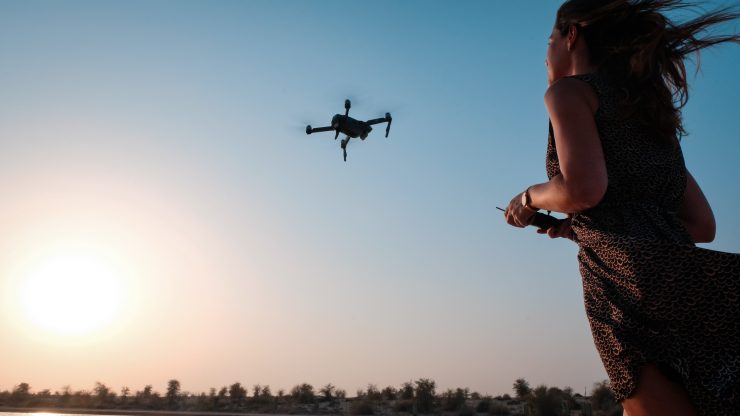Drones: they are fun to fly, but they are becoming a nuisance. Have you heard that drones spotted near airports will be shot down? The reason is that most people don’t know how to use drones ethically. Most people also don’t know how to fly a drone when they get one. Before you take your drone out for a test ride, you should know how to use it first.
So, how do you fly a drone? Here are tips on the proper way to fly a drone like the guys flying military drones – like a pro!
How To Fly a Drone
- Learn the Controls
- Learn about the Set Regulations
- Practice
- Always Inspect your Drone
- Take-Off and Landing
- Always Maintain a Clear Line of Sight
- Mind the Drone’s Transmission Range
- Fly in Ample Lighting
- Have Fun!
Learn the Controls
There is a standard design for every drone controller: the main feature is a control stick – which you use to direct the drone – and several buttons for other functions. However, different drones sport different features, and they all are accessible through the controller. It is important to understand your drone’s features and capabilities if you wish to use it to its fullest potential.
Every drone comes with a user manual. Before you take it off the ground, skim through the manual and concentrate on the controls and features section. No one reads the manual, right? However, you can spend a lot of time learning about your drone if you don’t read the manual.
It may not seem cool, and you may be in a rush to test out your new drone, but it is prudent – and you will get to learn about your drone’s full potential without beating around the bush.
Learn about the Set Regulations
As mentioned, the authorities are considering shooting down drones that fly too close to airports and other sensitive institutions. Authorities are also setting up regulations on where you can and cannot fly a drone.
You may not have any malicious intentions, but you will still be held accountable if you breach the rules. As such, take some time to learn about your area’s drone-flying regulations. Are you allowed to fly your drone around the neighborhood? Should your drone have a camera? Can you fly your drone indoors?
You will be surprised by some of the stipulations in some of the laws regulating flying of drones. Also keep in mind that these laws are dynamic since personal drones are relatively new, so stay updated.
Practice
Drone makers endeavor to make your experience as easy and as fun as possible. However, no matter how simple the controls may seem, you have to practice to get the hang of it. Your neighbors will not appreciate a drone hovering over their houses, especially if it is fitted with a camera. And, if you are an amateur at it, you may end up crashing your drone into a wall or a tree.
Before you hone your skills, you should look for a place with the ideal terrain to practice. The ideal terrain should be an open space without obstacles such as buildings and trees. The place should also ideally be quiet for concentration purposes.
You should also take into account weather conditions – for instance, strong winds will disrupt your course and mess up your training.
If you have a hard time finding the ideal flying space to practice, study satellite maps – this way you will also find areas where you can fly your drone to its full mileage range.
Always Inspect Your Drone
Gadgets are not entirely reliable, and drones most so! Complications may lead to defects such as the propellers cracking, or the drone camera failing. Any defect in your drone will compromise its flying, and if you fly the drone with such defects it may crash.
As such, always inspect your drone before and after flying. Pay close attention to the propellers, as they are the most crucial part of the drone. If you notice any defects, be sure to repair or replace before flying the drone again.
Take-Off and Landing
Slow and gentle is the name of the game when it comes to taking off and landing. Drones are like planes: taking off and landing are the hardest parts of flying. If you are not careful, you may crash your drone before it gets into the air or lands.
Be gentle when taking off. First, check the weather – ideally, your drone should take off when the weather is calm or else it will crash. Second, check the drone’s vitals – if your drone doesn’t have enough power it will crash shortly after take-off. When taking off, choose an open area without obstacles. Let the drone hover in the air for a while before increasing the throttle to start flying around.
Landing is just as complicated. If the drone lands too fast or too hard, it may crash and destroy vital parts such as the camera and propeller. So, be as gentle when landing as you were when taking off. Again, choose a spot without obstacles.
The landing spot should also be soft in case the drone crashes. Make sure that you land your drone before the power runs out, or else it will fall and crash. And, just to be safe, buy a landing pad specified for your drone.
NB: Always check the drone’s vitals when taking off, flying, and landing.
Always Maintain a Clear Line of Sight
Every respectable drone should have a HD camera on board – otherwise, it may just be a drone for kids. Nevertheless, your drone’s camera should not be your eyes. What if the signal fails? If that happens, or anything else happens to the camera, your drone will be lost.
As such, always maintain a clear line of sight so you can see everywhere your drone goes. This is why, as mentioned, you should ideally fly your drone in an area without obstacles that may impede your sight.
Most people do not heed this advice, but if you value your investment you will be smarter about it – gadgets are not entirely reliable. You may not care as much about a budget drone, but a high quality, expensive device deserves extra care.
Mind the Drone’s Transmission Range
How far can your drone fly? You will find the answer to this question on your drone’s user manual – again, it is prudent to always read the user manual.
Drones rely on GPS networks from satellites. Military drones can fly for thousands of miles away from the command center, but consumer drones are limited to a few dozen miles, depending on the brand. If you drone flies past its set range, it will become unresponsive and drop out of the air like a stone on free-fall. Again, this is why you should always fly your drone within your line of sight.
To avoid loss in transmission, make sure that there are at least ten satellites available before flying your drone. Additionally, check to see that there are at least four bars signaling a strong GPS signal.
Fly in Ample Lighting
Some drones have sophisticated cameras with infra-red lighting that allows you to see clearly as you fly in the dark. However, as mentioned, gadgets are not entirely reliable. Flying your of range is bad enough, but losing your drone in the dark is worse – you will have a hard time finding it.
You should fly your drone in the daytime with ample lighting. And, as mentioned, the weather should be calm – ideally sunny so your photos come out crystal clear.
Have Fun!
The first drones were used for military purposes such as spying, reconnaissance, and bombing. However, your drone should be used for fun – it should give you a thrill.
After you have made sure that you have complied with all these regulations, be sure to have fun when flying your drone. Explore new places, but do not spy on your neighbors – there is concern that people are using drones to peep on other people, and that is why the authorities are passing laws regulating flying of drones.
Having fun should not be mistaken for flying aggressively. If you wish to keep your drone for as long as possible, be gentle with it! Push the control stick gently and, as mentioned, be particularly gentle when taking off and landing.
Buy the Right Drone
Drones are becoming more and more sophisticated. Some of the latest drones have a longer flying range, better battery capacities, crystal-clear cameras, and a wide range of other features that you may not even expect. And, since a drone is just like an investment, be sure to buy the best drone you can afford. Take into consideration these drones, which have been ranked as the best:
- Best Drones Under $100
- Best Drones Under $200
- Mini and Micro Drones
- Waterproof Drones
- Selfie Drones
- Photography Drones
- Star Wars Drones
- Best Kids Drones
Final Word
Drones can be fun or a nuisance! If you wish to make the most out of your drone, learn how to use and fly it. These tips are recommended by drone makers and passionate drone users. Heed them and you will not only have fun flying your drone, but you will also keep it for longer. Additionally, buy the best drone that you can get to enjoy the best of the latest technology.







Add comment